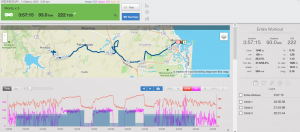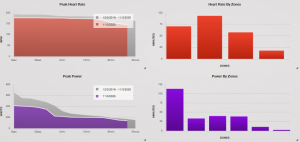You may have heard the term ‘strengthies’ used to describe a type of bike training session. Strengthies (or strength endurance) can mean different things to different coaches and riders. But typically it is referring to a session that includes intervals that are done at a lower than normal cadence. Often these intervals are done uphill as it is easier to get the overload you are chasing uphill when compared to the flat. They can be programmed on the flat as well, but it’s harder to produce the power necessary.
Why do we program them?
Coaches and sport scientists schedule these sessions when they are trying to focus on peripheral adaptation. This means they are stimulating overload in the muscles as opposed to the cardiovascular system. The way to do this is to decrease cadence so the load is taken off the rider centrally, and distributed to the legs. At a general level, we could say we are seeking a metabolic adaptation in the muscles rather than a cardiovascular adaption centrally. Of course it is not as black and white as that, but overall it’s a reasonable way of describing it.
I’ll cover off the cadence to use, and when to use strength endurance sessions in the annual training program later on in this blog. For now let’s look at a recent session to illustrate strengthies in action.
This data is mine, from a session I did this morning. I’m 8 weeks out from Grafton to Inverell (G2I) and very conscious of the amount of climbing I need to do in this training block. G2I has an 18km steady climb on a 5% gradient. There are no climbs similar to this on the Sunshine Coast. So my workaround today was to do three climbs up to Montville which is 6km at around 5%.

First thing you may notice is I was compliant with my own programmed session and ‘got a green’ in TrainingPeaks. Yay me. You can also see I wasn’t completely compliant by looking at the blue background of the workout build. The pink overlay of my power doesn’t match the timing exactly. That’s because I descended like a granny as the roads were greasy from the overnight rain and the descent is a bit sketchy. That’s my story and I am sticking to it! Jokes aside, as an athlete, it’s important not to get too hung up in this kind of detail. The main thing is to look at the overall intent of the session. Was it met? In this case, it looks like it was, but let us take a closer look at the data. Here is the data for the 3 climbs using the ‘laps’ function in TrainingPeaks (make friends with the lap button, it is super helpful. You can also add laps later on when analysing the file if you forget to do it at the time).

I’ve marked the most relevant metrics with the red arrow – Intensity Factor (IF), average heart rate and cadence. The IF is a measure of the power used relative to your FTP. An IF of 1.0 means you rode the interval/section exactly at your FTP. These climbs were 21-22 minutes and I had programmed a target for myself of 1.0. This is quite attainable. You can see I rode them at 0.94, 0.95 and 0.93. I get marks for consistency, but they are not quite at the desired intensity. I describe this as ‘tapping at the bottom of the window instead of climbing through it’. But it’s not too bad, and certainly the power is well and truly in Z4. In my defence, I did these climbs to feel as I can’t see my Garmin fields properly without prescription glasses on. But I think that riding ‘to feel’ is sometimes useful.
Now let’s have a look at cadence. I did all three climbs in the big chain ring (BCR) – for me that’s a 52, and the predominant gearing was the 25. It’s the first time I have tried this and you can see that the cadence came in pretty low at 66, 62 and 62. I could feel a little cross chaining sometimes, but I tried to work my way through it as I really wanted to see if I could do this climb 3 times on the BCR.
What effect did that have on my heart rate? The average heart rate across the climbs was 158, 158 and 160. This is only meaningful if you know what my threshold and max heart rate are. My threshold is in the low 170s and my max is in the high 180s. So climbing in the 158-160 range for me is Z3 tempo. In other words, very controlled. Very very controlled, in fact. Perhaps a little too controlled. I had more to play with heart rate wise and could have pushed it a little more to get the power closer to FTP.
What does the zone distribution look like when we compare power and heart rate? The intent of this session was 60 minutes at threshold power or thereabouts. If done correctly what we should see is 60 minutes in power Z4, but far less time than that in heart rate Z4. Here’s the distribution:

TrainingPeaks is nice and helpful, and if you hover over these bars while analysing a file it will tell you the amount of time in zone. To summarise: Heart rate was only 17 minutes in Z4 or above and power was 51 minutes in Z4 or above.
So these ‘strengthies’ were pretty well executed. If I was giving feedback to an athlete I’d say:
- Nice controlled session, very consistent
- Power was good but next time try and stretch it a little higher
- Up your cadence slightly to the high 60s. This will likely increase your heart rate, but the power will be a bit higher too.
- Today I’m giving you 8/10 (that’s a joke, I don’t really do that).
So, what cadence should you use?
Well this is an interesting question. Back when I first started cycling ‘old school’ coaches would program super low cadence workouts, sometimes in the 40s and 50s. Many riders reported knee aggravation from doing these sessions so they went out of favour. Plus research demonstrated you could get similar responses from a much more palatable cadence in the 60s or 70s. I typically like to program mine around the 70 mark, but this varies between riders. All riders have a sweet spot cadence they like to ride at up hills. This is the cadence that gives them the best power whilst protecting their heart rate at the same time. If you are doing reps you should experiment with it to determine what works for you.
When should you do Strength Endurance work?
I generally program strengthies after the base preparation and before the event specific preparation. I favour doing them in a block (sometimes called block periodisation). This could last 4 weeks and might be something like 8 weeks out from the event (so week 8 through to week 4 pre-event). I wouldn’t program them in the last 4 weeks as I am chasing more specificity at this point in time, plus low cadence work can lead to more leg fatigue and DOMS in some athletes. I also use them if an athlete is struggling doing their threshold work with controlling their heart rate. That is, heart rate is the limiter rather than power. A few sessions of strengthies can help get this balance back for the athlete.